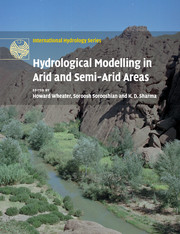Book contents
- Frontmatter
- Contents
- List of contributors
- Preface
- Acknowledgements
- 1 Modelling hydrological processes in arid and semi-arid areas: an introduction
- 2 Global precipitation estimation from satellite imagery using artificial neural networks
- 3 Modelling semi-arid and arid hydrology and water resources: The southern Africa experience
- 4 Use of the IHACRES rainfall-runoff model in arid and semi-arid regions
- 5 KINEROS2 and the AGWA modelling Framework
- 6 Ephemeral flow and sediment delivery modelling in the Indian arid zone
- 7 The modular modelling system (MMS): a toolbox for water and environmental resources management
- 8 Calibration, uncertainty, and regional analysis of conceptual rainfall-runoff models
- 9 Real-time flow forecasting
- 10 Real-time flood forecasting: Indian experience
- 11 Groundwater modelling in hard-rock terrain in semi-arid areas: experience from India
- Appendix Access to software and data products
- Index
- Plate section
- References
1 - Modelling hydrological processes in arid and semi-arid areas: an introduction
Published online by Cambridge University Press: 15 December 2009
- Frontmatter
- Contents
- List of contributors
- Preface
- Acknowledgements
- 1 Modelling hydrological processes in arid and semi-arid areas: an introduction
- 2 Global precipitation estimation from satellite imagery using artificial neural networks
- 3 Modelling semi-arid and arid hydrology and water resources: The southern Africa experience
- 4 Use of the IHACRES rainfall-runoff model in arid and semi-arid regions
- 5 KINEROS2 and the AGWA modelling Framework
- 6 Ephemeral flow and sediment delivery modelling in the Indian arid zone
- 7 The modular modelling system (MMS): a toolbox for water and environmental resources management
- 8 Calibration, uncertainty, and regional analysis of conceptual rainfall-runoff models
- 9 Real-time flow forecasting
- 10 Real-time flood forecasting: Indian experience
- 11 Groundwater modelling in hard-rock terrain in semi-arid areas: experience from India
- Appendix Access to software and data products
- Index
- Plate section
- References
Summary
INTRODUCTION
In the arid and semi-arid regions of the world, water resources are limited, and under severe and increasing pressure due to expanding populations, increasing per capita water use and irrigation. Point and diffuse pollution, increasing volumes of industrial and domestic waste, and over-abstraction of groundwater provide a major threat to those scarce resources. Floods are infrequent, but extremely damaging, and the threat from floods to lives and infrastructure is increasing, due to urban development. Ecosystems are fragile, and under threat from groundwater abstractions and the management of surface flows. Added to these pressures is the uncertain threat of climate change. Clearly, effective water management is essential, and this requires appropriate decision support systems, including modelling tools.
Modelling methods have been widely used for over 40 years for a variety of purposes, but almost all modelling tools have been primarily developed for humid area applications. Arid and semi-arid areas have particular challenges that have received little attention. One of the primary aims of this workshop is to bring together world-wide experience and some of the world's leading experts to provide state-of-the-art guidance for modellers of arid and semi-arid systems.
The development of models has gone hand-in-hand with developments in computing power. While event-based models originated in the 1930s and could be used with hand calculation, the first hydrological models for continuous simulation of rainfall-runoff processes emerged in the 1960s, when computing power was sufficient to represent all of the land-phase processes in a simplified, “conceptual” way.
Information
- Type
- Chapter
- Information
- Hydrological Modelling in Arid and Semi-Arid Areas , pp. 1 - 20Publisher: Cambridge University PressPrint publication year: 2007
References
Accessibility standard: Unknown
Why this information is here
This section outlines the accessibility features of this content - including support for screen readers, full keyboard navigation and high-contrast display options. This may not be relevant for you.Accessibility Information
- 17
- Cited by
